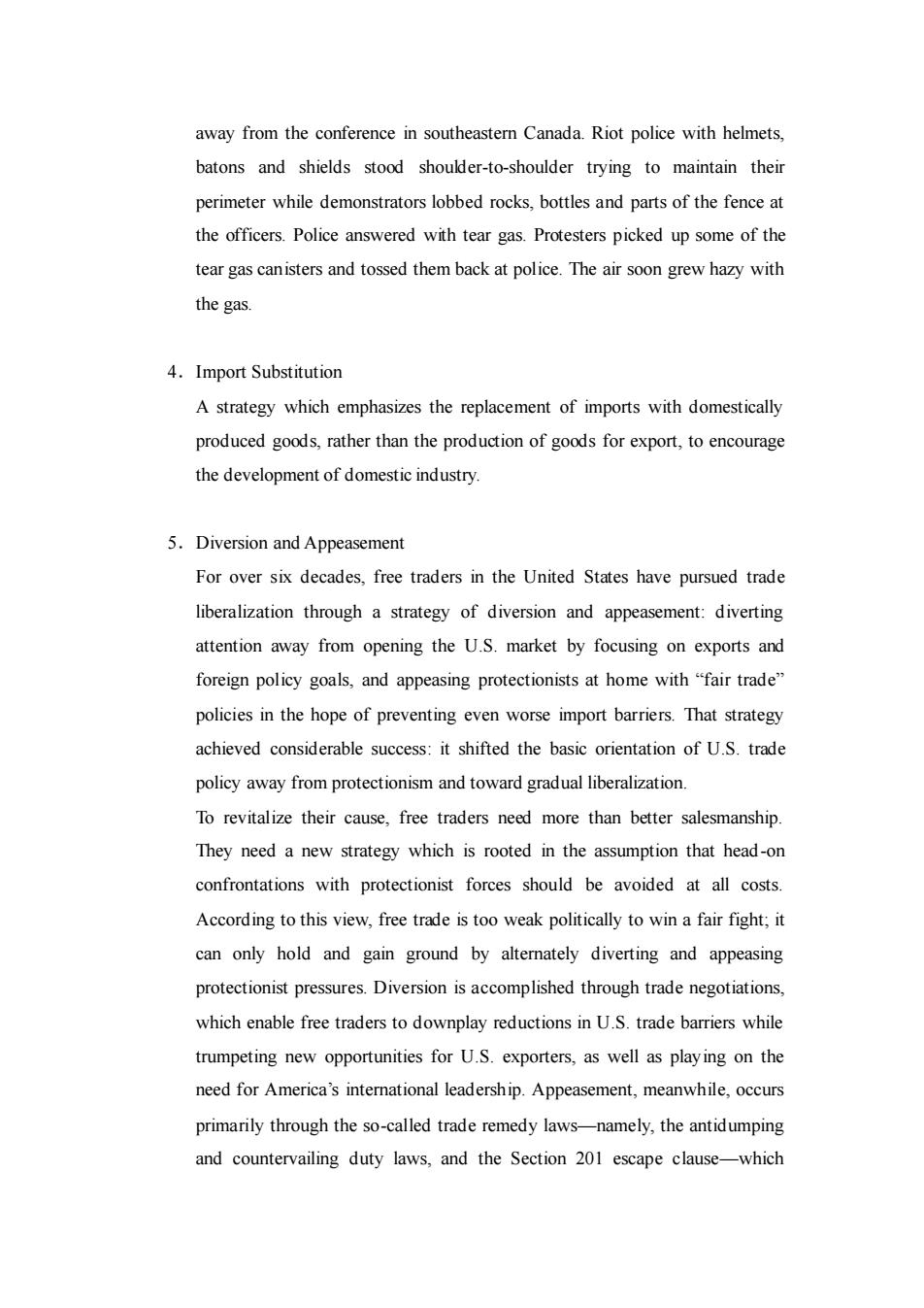正在加载图片...

away from the conference in southeastern Canada.Riot police with helmets, batons and shields stood shoulder-to-shoulder trying to maintain their perimeter while demonstrators lobbed rocks,bottles and parts of the fence at the officers.Police answered with tear gas.Protesters picked up some of the tear gas canisters and tossed them back at police.The air soon grew hazy with the gas. 4.Import Substitution A strategy which emphasizes the replacement of imports with domestically produced goods,rather than the production of goods for export,to encourage the development of domestic industry. 5.Diversion and Appeasement For over six decades,free traders in the United States have pursued trade liberalization through a strategy of diversion and appeasement:diverting attention away from opening the U.S.market by focusing on exports and foreign policy goals,and appeasing protectionists at home with "fair trade" policies in the hope of preventing even worse import barriers.That strategy achieved considerable success:it shifted the basic orientation of U.S.trade policy away from protectionism and toward gradual liberalization. To revitalize their cause,free traders need more than better salesmanship. They need a new strategy which is rooted in the assumption that head-on confrontations with protectionist forces should be avoided at all costs. According to this view,free trade is too weak politically to win a fair fight;it can only hold and gain ground by alternately diverting and appeasing protectionist pressures.Diversion is accomplished through trade negotiations, which enable free traders to downplay reductions in U.S.trade barriers while trumpeting new opportunities for U.S.exporters,as well as play ing on the need for America's international leadership.Appeasement,meanwhile,occurs primarily through the so-called trade remedy laws-namely,the antidumping and countervailing duty laws,and the Section 201 escape clause-whichaway from the conference in southeastern Canada. Riot police with helmets, batons and shields stood shoulder-to-shoulder trying to maintain their perimeter while demonstrators lobbed rocks, bottles and parts of the fence at the officers. Police answered with tear gas. Protesters picked up some of the tear gas canisters and tossed them back at police. The air soon grew hazy with the gas. 4.Import Substitution A strategy which emphasizes the replacement of imports with domestically produced goods, rather than the production of goods for export, to encourage the development of domestic industry. 5.Diversion and Appeasement For over six decades, free traders in the United States have pursued trade liberalization through a strategy of diversion and appeasement: diverting attention away from opening the U.S. market by focusing on exports and foreign policy goals, and appeasing protectionists at home with “fair trade” policies in the hope of preventing even worse import barriers. That strategy achieved considerable success: it shifted the basic orientation of U.S. trade policy away from protectionism and toward gradual liberalization. To revitalize their cause, free traders need more than better salesmanship. They need a new strategy which is rooted in the assumption that head-on confrontations with protectionist forces should be avoided at all costs. According to this view, free trade is too weak politically to win a fair fight; it can only hold and gain ground by alternately diverting and appeasing protectionist pressures. Diversion is accomplished through trade negotiations, which enable free traders to downplay reductions in U.S. trade barriers while trumpeting new opportunities for U.S. exporters, as well as playing on the need for America’s international leadership. Appeasement, meanwhile, occurs primarily through the so-called trade remedy laws—namely, the antidumping and countervailing duty laws, and the Section 201 escape clause—which